Disease Detectives
This year's top young scientists faced medical challenges in labs at the National Institutes of Health.
By Emily Sohn
Anytown, U.S.A., has a serious problem. One of its residents is very sick. Doctors suspect avian influenza. The disease, also called bird flu, can be devastating.
“If we do nothing,” says Taylor Jones, the freckle-faced mayor of Anytown, “most likely, 70 percent of people in this town will die.”
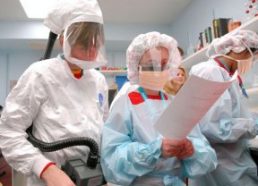 |
|
In a lab at the National Institutes of Health, student scientists Jack Grundy (left) and Erin Edwards tackle a make-believe avian-flu epidemic at this year’s Discovery Channel Young Scientist Challenge. |
| Photo by Bill Fitzpatrick |
While Jones and an epidemiologist use computer models to assess the town’s risk, a virologist scans mucus samples to prepare a diagnosis. The patient, a 33-year-old named Joe Plastic, lies in a hospital isolation unit. He’s struggling to breathe.
“He’s starting to die,” says Dr. Jayne Thompson.
The virologist, Kushal Naik, has more bad news.
“Joe is positive for avian flu, but that’s not the worst part,” Naik says. “We have nine specimens from other hospitals that are also positive. It’s spreading.”
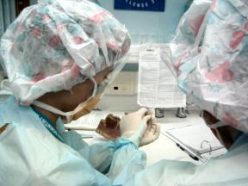 |
|
Jayne Thompson and William Pete take a mucus sample from Joe Plastic’s nose. |
| Emily Sohn |
This crisis ends quickly, however, mainly because it’s fictional. The team, ranging in age from 11 to 15, is tackling one of six 90-minute challenges at this year’s Discovery Channel Young Scientist Challenge (DCYSC).
Each fall, DCYSC brings 40 middle school science fair champs to Washington, D.C., to compete for more than $100,000 in scholarships, prizes, and the honor of being named “America’s Top Young Scientist of the Year.” Winners must combine problem solving with quick thinking, teamwork, and the ability to explain complicated ideas clearly.
Gut navigation
This year’s team competition, which had a medical theme, took place at the National Institutes of Health (NIH) in Bethesda, Md. Most challenges involved real-world medical problems. And cutting-edge NIH researchers were there to help.
“We try to deal with issues in the news,” says Steve “Jake” Jacobs, head DCYSC judge. “NIH provided us with an opportunity available nowhere else on the planet.”
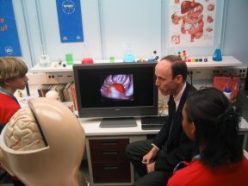 |
|
NIH radiologist Ronald Summers explains the basics of reading a computerized tomography scan. |
| Emily Sohn |
NIH researcher Ronald Summers, for example, studies virtual colonoscopy, a new way to screen for cancer of the colon (or large intestine). The technique combines X-ray–like computerized tomography (CT) scans with computer software to create three-dimensional videos of the inside of the colon. Doctors can then check the images for polyps, mushroomlike growths that can become cancerous.
The new diagnostic method is more comfortable for patients than the standard procedure. In that procedure, “you insert the scope into the patient’s bottom and thread it through,” Summers says. “A light and digital camera show you everything.”
To compare the standard and new methods, students tried out each one. To perform a mock CT exam, they navigated through virtual images of five colons to spot the polyps in each. For the standard method, students threaded a 63-inch-long scope through a plastic model of a human colon. A screen displayed what was inside.
Steering the probe through the twists and folds of the colon was difficult. “I have no idea what I’m looking at,” Otana Jakpor, 12, admitted at one point. Teammate Jack Grundy, 13, punctured the fake patient’s intestinal wall by mistake.
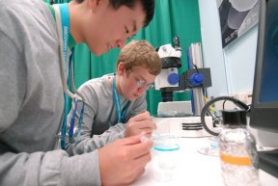 |
|
Nolan Kamitaki and Anthony Hennig separate zebrafish embryos in a petri dish in the NIH labs. |
| Photo by Bill Fitzpatrick |
Before the challenge ended, the colon explorers regrouped with teammates who had been injecting glowing proteins into see-through fish embryos. Together, the team needed to make a 3-minute, kid-to-kid video about new ways to look inside organisms.
Lunchtime
Downstairs, a different group of finalists battled another public health crisis: obesity (see “Packing Fat”).
First, the team had to assemble a 500-calorie lunch from a selection of foods whose nutritional labels were hidden. The team picked a chicken wrap, a banana, carrot sticks, Fig Newtons, and milk.
The students were dismayed to learn that they’d overshot their mark: The lunch they’d assembled packed a walloping 885 calories.
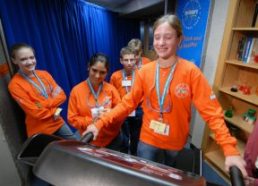 |
|
Jayleen McAlpine demonstrates on a treadmill how much effort it takes to burn calories while her teammates look on. |
| Photo by Bill Fitzpatrick |
Next, they used a chart, a treadmill, and their mathematics skills to figure out how much exercise it would take for a 125-pound person to burn off such a lunch.
After arguing about who would actually do so much exercise, they settled on four choices: an hour of basketball, an hour of tennis, 30 minutes of walking, and 30 minutes of lawn mowing.
Finally, the team created a podcast about energy balance and weight control.
“If people realized they had to do all that [exercise to burn off the calories in] a cookie, they might change their minds,” Joseph Church, 14, said.
Collin McAliley, 13, was unconvinced. “It’s such a good cookie, though,” he said.
Grand prize
DCYSC involved more than challenges, dinners, meeting people, and having fun. On the final morning, the finalists visited an elementary school in Washington, D.C. They fielded questions, demonstrated science experiments, and helped kids with their science projects.
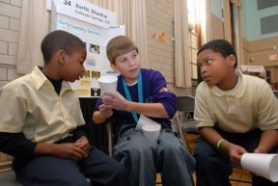 |
|
DCYSC competitor Joel Tinker demonstrates an experiment to two students at a Washington, D.C., school. |
| Photo by Bill Fitzpatrick |
At the awards ceremony, the grand prize, a $20,000 scholarship, went to Nolan Kamitaki, 14, of Waiakea Intermediate School in Hilo, Hawaii.
Jacob “Pi” Hurwitz, 14, of Robert Frost Middle School in Rockville, Md., received a $10,000 scholarship. His nickname reflects his ability to recite 320 decimal digits of the number pi.
Amy David, 15, of Pinedale Middle School in Wyo., won third place and a $5,000 scholarship.
“One reason we’re happy to have such bright, energetic people getting into science is that you are the next generation of leaders,” NIH’s Anthony Fauci told the finalists. “You are choosing a life of discovery and a probing of the unknown. It’s a most unusual and extraordinary life.”
Going Deeper:







